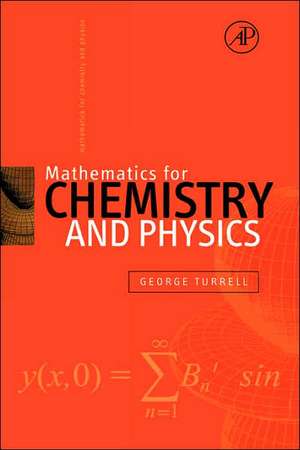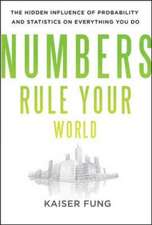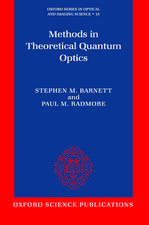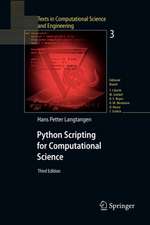Mathematics for Chemistry and Physics
Autor George Turrellen Limba Engleză Hardback – 3 dec 2001
Designed as a reference text, Mathematics for Chemistry and Physics will prove beneficial for students at all university levels in chemistry, physics, applied mathematics, and theoretical biology. Although this book is not computer-based, many references to current applications are included, providing the background to what goes on "behind the screen" in computer experiments.
Preț: 420.97 lei
Nou
Puncte Express: 631
Preț estimativ în valută:
80.58€ • 87.56$ • 67.73£
80.58€ • 87.56$ • 67.73£
Carte tipărită la comandă
Preluare comenzi: 021 569.72.76
Specificații
ISBN-13: 9780127050515
ISBN-10: 0127050515
Pagini: 424
Dimensiuni: 152 x 229 x 28 mm
Greutate: 0.72 kg
Editura: ELSEVIER SCIENCE
ISBN-10: 0127050515
Pagini: 424
Dimensiuni: 152 x 229 x 28 mm
Greutate: 0.72 kg
Editura: ELSEVIER SCIENCE
Public țintă
Primary market is undergraduate and postgraduate students in chemistry, chemical physics, materials science and physics. Secondary audiences are theoretical biologists and researchers.Cuprins
Preface1 Variables and Functions 1.1 Introduction 1.2 Functions 1.3 Classification and Properties of Functions 1.4 Exponential and Logarithmic Functions 1.5 Applications of Exponential and Logarithmic Functions 1.6 Complex Numbers 1.7 Circular Trigonometric Functions 1.8 Hyperbolic Functions Problems2 Limits, Derivatives and Series 2.1 Definition of a Limit 2.2 Continuity 2.3 The Derivative 2.4 Higher Derivatives 2.5 Implicit and Parametric Relations 2.6 The Extrema of a Function and Its Critical Points 2.7 The Differential 2.8 The Mean-Value Theorem and l’Hospital’s Rule 2.9 Taylor's Series 2.10 Binomial Expansion 2.11 Tests of Series Convergence 2.12 Functions of Several Variables 2.13 Exact Differentials Problems3 Integration 3.1 The Indefinite Integral 3.2 Integration Formulas 3.3 Methods of Integration 3.3.1 Integration by Substitution 3.3.2 Integration by Parts 3.3.3 Integration of Partial Fractions 3.4 Definite Integrals 3.4.1 Definition 3.4.2 Plane Area 3.4.3 Line Integrals 3.4.4 Fido and his Master 3.4.5 The Gaussian and Its Moments 3.5 Integrating Factors 3.6 Tables of Integrals Problems4 Vector Analysis 4.1 Introduction 4.2 Vector Addition 4.3 Scalar Product 4.4 Vector Product 4.5 Triple Products 4.6 Reciprocal Bases 4.7 Differentiation of Vectors 4.8 Scalar and Vector Fields 4.9 The Gradient 4.10 The Divergence 4.11 The Curl or Rotation 4.12 The Laplacian 4.13 Maxwell's Equations 4.14 Line Integrals 4.15 Curvilinear Coordinates Problems5 Ordinary Differential Equations 5.1 First-Order Differential Equations 5.2 Second-Order Differential Equations 5.2.1 Series Solution 5.2.2 The Classical Harmonic Oscillator 5.2.3 The Damped Oscillator 5.3 The Differential Operator 5.3.1 Harmonic Oscillator 5.3.2 Inhomogeneous Equations 5.3.3 Forced Vibrations 5.4 Applications in Quantum Mechanics 5.4.1 The Particle in a Box 5.4.2 Symmetric Box 5.4.3 Rectangular Barrier: The Tunnel Effect 5.4.4 The Harmonic Oscillator in Quantum Mechanics 5.5 Special Functions 5.5.1 Hermite Polynomials 5.5.2 Associated Legendre Polynomials 5.5.3 The Associated Laguerre Polynomials 5.5.4 The Gamma Function 5.5.5 Bessel Functions 5.5.6 Mathieu Functions 5.5.7 The Hypergeometric Functions Problems6 Partial Differential Equations 6.1 The Vibrating String 6.1.1 The Wave Equation 6.1.2 Separation of Variables 6.1.3 Boundary Conditions 6.1.4 Initial Conditions 6.2 The Three-Dimensional Harmonic Oscillator 6.2.1 Quantum-Mechanical Applications 6.2.2 Degeneracy 6.3 The Two-Body Problem 6.3.1 Classical Mechanics 6.3.2 Quantum Mechanics 6.4 Central Forces 6.4.1 Spherical Coordinates 6.4.2 Spherical Harmonics 6.5 The Diatomic Molecule 6.5.1 The Rigid Rotator 6.5.2 The Vibrating Rotator 6.5.3 Centrifugal Forces 6.6 The Hydrogen Atom 6.6.1 Energy 6.6.2 Wavefunctions and The Probability Density 6.7 Binary Collisions 6.7.1 Conservation of Angular Momentum 6.7.2 Conservation of Energy 6.7.3 Interaction Potential: LJ (6-12) 6.7.4 Angle of Deflection 6.7.5 Quantum Mechanical Description: The Phase Shift Problems7 Operators and Matrices 7.1 The Algebra of Operators 7.2 Hermitian Operators and Their Eigenvalues 7.3 Matrices 7.4 The Determinant 7.5 Properties of Determinants 7.6 Jacobians 7.7 Vectors and Matrices 7.8 Linear Equations 7.9 Partitioning of Matrices 7.10 Matrix Formulation of the Eigenvalue Problem 7.11 Coupled Oscillators 7.12 Geometric Operations 7.13 The Matrix Method in Quantum Mechanics 7.14 The Harmonic Oscillator Problems8 Group Theory 8.1 Definition of a Group 8.2 Examples 8.3 Permutations 8.4 Conjugate Elements and Classes 8.5 Molecular Symmetry 8.6 The Character 8.7 Irreducible Representations 8.8 Character Tables 8.9 Reduction of a Representation: The “Magic Formula 8.10 The Direct Product Representation 8.11 Symmetry-Adapted Functions: Projection Operators 8.12 Hybridization of Atomic Orbitals 8.13 Crystal Symmetry Problems9 Molecular Mechanics 9.1 Kinetic Energy 9.2 Molecular Rotation 9.2.1 Euler's Angles 9.2.2 Classification of Rotators 9.2.3 Angular Momenta 9.2.4 The Symmetric Top in Quantum Mechanics 9.3 Vibrational Energy 9.3.1 Kinetic Energy 9.3.2 Internal Coordinates: The G Matrix 9.3.3 Potential Energy 9.3.4 Normal Coordinates 9.3.5 Secular Determinant 9.3.6 An Example: The Water Molecule 9.3.7 Symmetry Coordinates 9.3.8 Application to Molecular Vibrations 9.3.9 Form of Normal Modes 9.4 Nonrigid Molecules 9.4.1 Molecular Inversion 9.4.2 Internal Rotation 9.4.3 Molecular Conformation: The Molecular Mechanics Method Problems10 Probability and Statistics 10.1 Permutations 10.2 Combinations 10.3 Probability 10.4 Stirling's Approximation 10.5 Statistical Mechanics 10.6 The Lagrange Multipliers 10.7 The Partition Function 10.8 Molecular Energies 10.8.1 Translation 10.8.2 Rotation 10.8.3 Vibration 10.9 Quantum Statistics 10.9.1 The Indistinguishability of Identical Particles 10.9.2 The Exclusion Principle 10.9.3 Fermi–Dirac Statistics 10.9.4 Bose–Einstein Statistics 10.10 Ortho- and Para-Hydrogen Problems11 Integral Transforms 11.1 The Fourier Transform 11.1.1 Convolution 11.1.2 Fourier Transform Pairs 11.2 The Laplace Transform 11.2.1 Examples of Simple Laplace Transforms 11.2.2 The Transform of Derivatives 11.2.3 Solution of Differential Equations 11.2.4 Laplace Transforms: Convolution and Inversion 11.2.5 Green's Functions Problems12 Approximation Methods in Quantum Mechanics 12.1 The Born–Oppenheimer Approximation 12.2 Perturbation Theory: Stationary States 12.2.1 Nondegenerate Systems 12.2.2 First-Order Approximation 12.2.3 Second-Order Approximation 12.2.4 The Anharmonic Oscillator 12.2.5 Degenerate Systems 12.2.6 The Stark Effect of the Hydrogen Atom 12.3 Time-Dependent Perturbations 12.3.1 The Schr¨Odinger Equation 12.3.2 Interaction of Light and Matter 12.3.3 Spectroscopic Selection Rules 12.4 The Variation Method 12.4.1 The Variation Theorem 12.4.2 An Example: The Particle in a Box 12.4.3 Linear Variation Functions 12.4.4 Linear Combinations of Atomic Orbitals (LCAO) 12.4.5 The H¨Uckel Approximation Problems13 Numerical Analysis 13.1 Errors 13.1.1 The Gaussian Distribution 13.1.2 The Poisson Distribution 13.2 The Method of Least Squares 13.3 Polynomial Interpolation and Smoothing 13.4 The Fourier Transform 13.4.1 The Discrete Fourier Transform (DFT) 13.4.2 The Fast Fourier Transform (FFT) 13.4.3 An Application: Interpolation and Smoothing 13.5 Numerical Integration 13.5.1 The Trapezoid Rule 13.5.2 Simpson's Rule 13.5.3 The Method of Romberg 13.6 Zeros of Functions 13.6.1 Newton's Method 13.6.2 The Bisection Method 13.6.3 The Roots: An Example ProblemsAppendices I The Greek Alphabet II Dimensions and Units III Atomic Orbitals IV Radial Wavefunctions for Hydrogenlike Species V The Laplacian Operator in Spherical Coordinates VI The Divergence Theorem VII Determination of the Molecular Symmetry Group VIII Character Tables for Some of the More Common Point Groups IX Matrix Elements for the Harmonic Oscillator X Further ReadingApplied MathematicsChemical PhysicsAuthor IndexSubject Index
Recenzii
"Chemistry and physics studies are very appealing to many students until they realize that they should have the necessary math skills to the understanding of chemistry and physics. I think that the book of Professor G. Turrell entitled "Mathematics for Physics and Chemistry " provides students with the mathematical bases that will help them to conduct their studies in an optimal conditions. The various chapters of the book introduces in pedagogical way important mathematical tools such as matrix, derivative, integral, differential equations with an illustration of the close interdependence between chemistry, physics and mathematics. I use this book for my own courses and I recommend this book for students." --Professor Nacer Idrissi (Lille, France)











